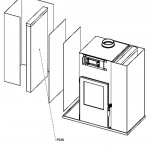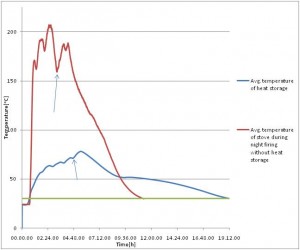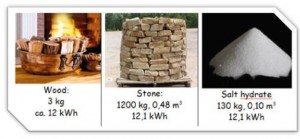
With the increasing insulation of domestic households and building requirements for energy efficiency in new buildings, the demand for high effect stoves has reduced. Wood burning stoves often deliver a high heating effect for but for a limited time, thereby creating temperature spikes in the surrounding space. A recent research conducted by Danish Technological Institute in collaboration with stove manufacturer, Morsø Jernstøberi has developed an innovative solution to prolong the period of heat release of wood stoves by using a phase change material, namely salt hydrate.
By charging a heat storage with a part of the energy released by burning wood, it is possible to heat the surrounding space at a lower temperature but over a longer period. Typically stones have been used as heat storage solution, but must be used in large mass and volume. By using a phase change material, 1200 kg of stones can be replaced by 130 kg of salt hydrate thereby making it more suitable for the average house.
Another outcome of PCM as heat storage would be that the so-called night firing could be avoided as you can keep a house warm for a longer period of time with stored heat. Night firing typically involves reduced valve settings and high emissions which would be eliminated.
Stove design with phase change material
The project with Morsøe Jernstøberi included the technical design and construction of a stove surrounded by plates with encased salt hydrate like a convection stove. The heat generated by the stove melts the salt hydrate at a temperature of approximately 60oC.
Experiments with both nominal charging and partial charging of the heat storage showed that the stove can supply heat above 30oC to the ambience for more than 14 hours. Nominal charging consisted of ignition, pre-charge and up to 5 nominal charges. Partial charging consisted of ignition, pre-charge and 1 nominal charge. Figure 1 shows a test run with nominal charging of the heat storage, showing that 14 hours after the last firing the average temperature of the heat storage still maintains temperatures above 30oC.

Night firing replaced by heat storage
To find out if night firing (the valve is reduced to a minimum and no flames present) could be substituted by heat storage and if a reduction of emission would be possible, the heat storage was removed and a test with night firing was conducted (ignition, pre-charge, charge, night firing charge). With night firing temperatures were above 30o C for a time between 6 and 8 hours compared to 10 hours for partial charge heat storage. However dust emissions for night firing were approx. 4.3 times higher than partial charging of the heat storage. This means that users can fire their stove with heat storage at 9 pm and still have a pleasant warmth at 7 am without any need to use the more environmentally damaging night-firing, as the heat storage capacity more than replaces night firing, even with only partial charging of the heat storage. In addition, the temperature is more steady than with a conventional stove as figure 1 showed. In this respect PCM can have a positive effect on both household heating and environment.
This post was written by Lene Skov Halgaard – Danish Technological Institute



